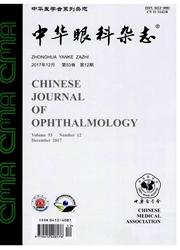

 中文摘要:
中文摘要:
目的探讨穿透性角膜移植术后慢性失功能移植片的超微结构改变及发生机制。方法角膜植片慢性失功(CCAD)组:穿透性角膜移植(PK)术后因CCAD导致移植失败的12只(12例患者)角膜植片;12例患者两次PK手术的平均间隔时间为69个月,10例患者初次PK术后曾发生1次或以上免疫排斥反应,2例患者未发现免疫排斥反应;正常对照组:由山东省眼库提供的5只角膜植片作为正常供体。对两组角膜片行组织病理学、透射电镜及扫描电镜检查,结合患者的病史进行综合分析。结果透射电镜观察发现CCAD组较正常对照组角膜上皮层变薄,可见大空泡形成,角膜基质层纤维排列紊乱,无明显炎性细胞浸润;后弹力层与角膜内皮细胞之间可见异常的间隙及纤维增生;角膜内皮层萎缩变薄,细胞变形、核染色质浓缩,偶见炎性细胞与角膜内皮细胞黏附。扫描电镜观察发现CCAD组较正常对照组角膜上皮细胞微绒毛数量明显减少,暗细胞增多;角膜内皮细胞数量减少,存在缺失区,内皮细胞可见凋亡小体。结论CCAD植片特征性超微结构改变是内皮细胞的萎缩性改变和非炎性细胞成分的纤维增生。慢性亚临床的抗原依赖与非抗原依赖因素可能共同参与了CCAD的发生,免疫排斥反应可能诱导和促进了CCAD的发生、发展。
 英文摘要:
英文摘要:
Objective To study the ultrastructure changes of failed graft caused by chronic corneal allngraft dysfunction (CCAD) after penetrating keratoplasty (PK), and to reveal the possible mechanism of these changes. Methods In CCAD group, corneas of 12 patients fulfilling the diagnostic criteria for CCAD who underwent repeated PK operation were studied. The average interval of these 12 patients between two PK operations was 69 months. All but two patients suffered at least once acute rejection episode during follow-up period. The mean time that the first acute immune rejection occurred was 39.4 months. Five healthy donor corneas were also studied as the control group. Both failed corneal grafts and healthy corneas were examined by light and electron microscopy. Results Compared with normal cornea, the cornea epithelium of CCAD became thinner, the quantity of microvillus apparently reduced, number of dark cells was increased, fibers of cornea stroma arranged disorderly, and there was no obvious invasion of inflammation cell into the stroma. The thickness of Descemet' s membrane was uneven, abnormal lacuna and red cell could be seen between the Deacemet' s membrane and the endothelium. The number of cornea endothelial cells was decreased, cells became thinner, the organelle was reduced obviously, notch appeared in the cell nucleus, chromatin was condensed and inflammatory cells was adherent to the endothelium. Conclusions The special ultrastructure changes of CCAD grafts consist of atrophic changes of the endothelium and fibrosis without inflammatory cells. Chronic subclinical alloantigen specific and non-alloantigen specific factors are beth contributed to the CCAD process. Acute immune rejection perhaps induces and accelerates the occurrence and development of CCAD.
 同期刊论文项目
同期刊论文项目
 同项目期刊论文
同项目期刊论文
 期刊信息
期刊信息
